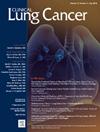Treatment-Switching Adjustment of Overall Survival in CheckMate 227 Part 1 Evaluating First-Line Nivolumab Plus Ipilimumab Versus Chemotherapy for Metastatic Nonsmall Cell Lung Cancer
IF 3.3
3区 医学
Q2 ONCOLOGY
引用次数: 0
Abstract
Objectives
CheckMate 227 (NCT02477826) evaluated first-line nivolumab-plus-ipilimumab versus chemotherapy in patients with metastatic nonsmall cell lung cancer (NSCLC) with programmed death ligand 1 (PD-L1) expression ≥ 1% or < 1% and no EGFR/ALK alterations. However, many patients randomized to chemotherapy received subsequent immunotherapy. Here, overall survival (OS) and relative OS benefit of nivolumab-plus-ipilimumab were adjusted for potential bias introduced by treatment switching.
Materials and methods
Treatment-switching adjustment analyses were conducted following the NICE Decision Support Unit Technical Support Document 16, for CheckMate 227 Part 1 OS data from treated patients (database lock, July 2, 2019). Inverse probability of censoring weighting (IPCW) was used in the base-case analysis; other methods were explored as sensitivity analyses.
Results
Of 1166 randomized patients, 391 (PD-L1 ≥ 1%) and 185 (PD-L1 < 1%) patients received nivolumab-plus-ipilimumab; 387 (PD-L1 ≥ 1%) and 183 (PD-L1 < 1%) patients received chemotherapy, with 29.3-month minimum follow-up. Among chemotherapy-treated patients, 169/387 (43.7%; PD-L1 ≥ 1%) and 66/183 (36.1%; PD-L1 < 1%) switched to immunotherapy poststudy. Among treated patients, median OS was 17.4 months with nivolumab-plus-ipilimumab versus 14.9 months with chemotherapy (hazard ratio [HR], 0.80; 95% confidence interval [CI], 0.68-0.95) in the PD-L1 ≥ 1% subgroup and 17.1 versus 12.4 months (HR, 0.62; 95% CI, 0.49-0.80) in the PD-L1 < 1% subgroup. After treatment-switching adjustment using IPCW, the HR (95% CI) for OS for nivolumab-plus-ipilimumab versus chemotherapy was reduced to 0.68 (0.56-0.83; PD-L1 ≥ 1%) and 0.53 (0.40-0.69; PD-L1 < 1%). Sensitivity analyses supported the robustness of the results.
Conclusion
Treatment-switching adjustments resulted in a greater estimated relative OS benefit with first-line nivolumab-plus-ipilimumab versus chemotherapy in patients with metastatic NSCLC.
CheckMate 227 第一部分评估转移性非小细胞肺癌一线 Nivolumab 加 Ipilimumab 与化疗的总生存期治疗转换调整试验
CheckMate 227 (NCT02477826)评估了程序性死亡配体1(PD-L1)表达≥1%或<1%且无/改变的转移性非小细胞肺癌(NSCLC)患者的一线nivolumab-plus-ipilimumab与化疗的对比。然而,许多随机接受化疗的患者随后又接受了免疫疗法。在此,对nivolumab-plus-ipilimumab的总生存期(OS)和相对OS获益进行了调整,以消除治疗转换带来的潜在偏差。治疗转换调整分析是根据NICE决策支持部门技术支持文件16,针对CheckMate 227第1部分治疗患者的OS数据(数据库锁定时间为2019年7月2日)进行的。在基础案例分析中使用了逆概率删减加权法(IPCW);在敏感性分析中探讨了其他方法。在1166例随机患者中,391例(PD-L1≥1%)和185例(PD-L1<1%)患者接受了nivolumab-plus-ipilimumab治疗;387例(PD-L1≥1%)和183例(PD-L1<1%)患者接受了化疗,随访时间最短为29.3个月。化疗患者中,169/387(43.7%;PD-L1≥1%)和66/183(36.1%;PD-L1<1%)人在研究后转为免疫疗法。在接受治疗的患者中,PD-L1≥1%亚组中,nivolumab加伊匹单抗的中位OS为17.4个月,化疗为14.9个月(危险比[HR],0.80;95%置信区间[CI],0.68-0.95);PD-L1<1%亚组中,中位OS为17.1个月,化疗为12.4个月(HR,0.62;95% CI,0.49-0.80)。使用IPCW进行治疗转换调整后,nivolumab加伊匹单抗与化疗相比的OS HR(95%CI)分别降至0.68(0.56-0.83;PD-L1≥1%)和0.53(0.40-0.69;PD-L1<1%)。敏感性分析证实了结果的稳健性。在转移性NSCLC患者中,治疗转换调整使一线nivolumab-plus-ipilimumab相对于化疗的估计相对OS获益更大。
本文章由计算机程序翻译,如有差异,请以英文原文为准。
求助全文
约1分钟内获得全文
求助全文
来源期刊

Clinical lung cancer
医学-肿瘤学
CiteScore
7.00
自引率
2.80%
发文量
159
审稿时长
24 days
期刊介绍:
Clinical Lung Cancer is a peer-reviewed bimonthly journal that publishes original articles describing various aspects of clinical and translational research of lung cancer. Clinical Lung Cancer is devoted to articles on detection, diagnosis, prevention, and treatment of lung cancer. The main emphasis is on recent scientific developments in all areas related to lung cancer. Specific areas of interest include clinical research and mechanistic approaches; drug sensitivity and resistance; gene and antisense therapy; pathology, markers, and prognostic indicators; chemoprevention strategies; multimodality therapy; and integration of various approaches.
 求助内容:
求助内容: 应助结果提醒方式:
应助结果提醒方式:


